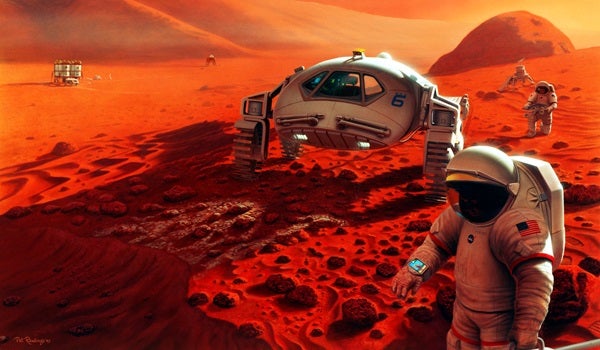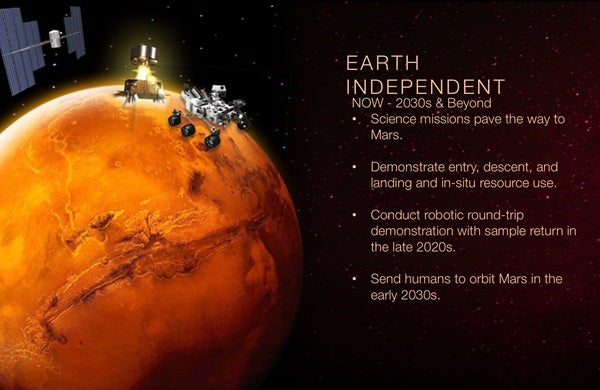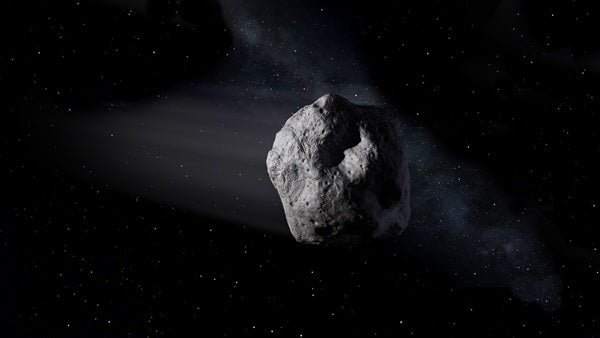Just because we rely on it now does not mean we always will, however. Now that we have the means to create spaceships and ways to mine other parts of the solar system, the idea of living without our planet is not out of the question.
In fact, if you ask Stephen Petranek, author of How We’ll Live on Mars, there is no question about it. If we want to ensure our survival as a species we have to colonise Mars. “There is a 100 percent probability that Earth will again be hit by a very large asteroid, like the one that killed the dinosaurs,” says Petranek, “and there would be nothing we could do about it.” If it happens on Earth, all humans would die. The only way to guarantee our species does not go extinct, he says, is to move some of it to Mars.
Sending humans to Mars involves deep space missions that could last months, but shipping material to Mars is expensive. The energy cost of shipping material increases by a factor of 100 if you want to take it to Mars. If the goal is to establish a long-term base on the Red Planet, or to relocate at least part of our species there for good, we will need to learn how to survive solely on materials found in space. Now researchers across the world are working to find the best ways to do this.
Creating a new base on another planet would be similar to going on a camping trip, with one addition. You need water, shelter, a power source, food and, unlike on Earth, you need oxygen.
In terms of shelter, a basic structure could be made out of martian regolith, which can be used to create bricks. But any home on another planet would need added protection against harmful space radiation. On Earth, our magnetic field does the job of deflecting cosmic rays, but on places like Mars this is not the case. A paper published earlier this year in Advances in Space Research showed that clay from carbonaceous asteroids could act as a more effective shield from radiation than aluminum.
Water is another vital resource. “Water is abundant in space,” says Dr Philip Metzger, from the University of Central Florida. “It exists as ice in the Moon’s dark polar craters, it is stored in the clay minerals in many asteroids, and it is found in a variety of forms on Mars.” On Mars there are many candidates from which water could be extracted, including the regolith (soil), hydrated minerals, and old glaciers buried under the surface.
In order to breathe, oxygen is quite crucial. Oxygen can also be combined with water to create useful things like methane, from which rocket fuel can be created. If water is abundant, oxygen can be produced through electrolysis, using a current to separate the positively charged hydrogen ions from the negatively charged oxygen.
Another way to create oxygen is atmospheric capture. First, carbon dioxide is captured from the atmosphere. NASA has created a system called MOXIE for the next Mars rover that will attempt to do exactly this. Oxygen can then be extracted from the carbon dioxide using gravity-based separation processes. These processes would take longer, since Mars’ gravity is lower, but there is no reason why they would not work.
For food, off-world farming techniques are tricky, but not impossible. Experiments on Earth using simulated martian soil, like Food for Mars and Moon, based in the Netherlands, have managed to grow tomatoes. It is thought the martian equator would be warm enough for inflatable greenhouses to grow plants, but these would also need a power source.
All of these techniques, while viable, remain largely theoretical. The first tests will have to be conducted on Mars, to match the true conditions, so the results are still years away at best.
Finding resources
“We face two possible scenarios for the future of humanity,” says Jason Dunn, co-founder and CTO of Made In Space, Inc. “One is where the human species never exploits resources off of planet Earth and instead uses only Earth-found resources.”
The other option, he says, is one in which we move beyond Earth to harness the resources in the inner solar system. “The second scenario in my mind is the only one worthy of pursuit because it is in the only option that ensures the survival, growth, and prosperity of humanity and really the rest of Earth’s biome.”
Made In Space’s premise is that one day, everything will be able to be created in space.
So, could we ever live completely independently from Earth? “It’s a complicated question, “ says Dunn, “but the answer has to be an unequivocal yes.”
“I think we could produce most of our things on Mars except perhaps the most sophisticated electronics and such,” says van Susante. “From a biological standpoint the picture is less clear since there may be trace elements and vitamins, that we would need to import.”
One of the biggest challenges in this line of research is funding, according to Dunn. For example, because it is cheaper, research is going into simulated lunar soil, or asteroid regolith, instead of obtaining the real thing. “Our first mining machines to the Moon or asteroids may be designed without ever being tested on a real asteroid or lunar soil and this can pose a real problem in design development,” he says.
The basis for these techniques, from capturing oxygen from the atmosphere or extracting clays from asteroids, is all there. We just need to work out how to do it. When it comes down to it, it is not a case of if we could live without Earth but when.
The future of our race depends on it. “Right now we all live on one single, vulnerable place,” says Professor Leslie Gertsch, from the Missouri University of Science and Technology. “If anything degrades the conditions on Earth enough that people can no longer live there — human-caused or just bad astronomical luck — we have nowhere else to go.”













